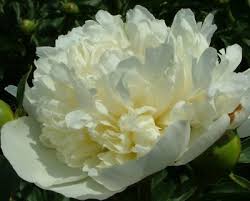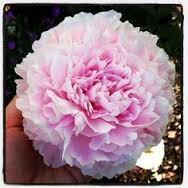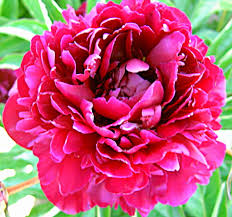PEONIES
Two main types of peonies are commonly grown in gardens: herbaceous peonies and tree peonies. Herbaceous peonies die to the ground every winter and regrow in spring. Tree peonies are shrubs; their flowers bloom early in spring on woody branches. Here we will discuss the herbaceous, perennial peonies whose flowers appear in early summer. Peonies are one of the best perennials for Montana and can be grown all over our state, even in very cold areas. I have seen fine plants blooming at East Glacier, Butte, Ronan, and Glendive.
Several species of peonies exist. One of the first grown in gardens was European, Paeonia officionalis (the Memorial Day Peony). The single form, with five petals, was grown in the Middle Ages. when the seeds were used medicinally. Later, in the late eighteenth century, Thomas Jefferson grew the double form in his garden. In the early 19th century several garden forms of the species Paeonia lactiflora arrived in Europe from China and Siberia. French nurserymen hybridized these with P. officionalis to develop new varieties. Several are grown today as valuable heirlooms, such as ‘Duchesse de Nemours’, from 1856, seen in the first picture above. ‘Germaine Bigot’ from 1902, is seen in the second picture. ‘Phillipe Rivoire’, from 1911 is the beautiful red. In the 20th century America became the center of hybridization for peonies; now hundreds of cultivars are available.
Herbaceous peonies are quite hardy, to USDA climate zone 2 and even to zone 1 with the protection of a winter mulch of evergreen boughs. The long-stemmed, large flowers of peonies are excellent for cutting. The shape and number of petals in peony flowers varies. The three basic flower forms of peonies include: single or semi-doubles with one or two rows of petals; Japanese, with five petals and large stamenoids (petal-like stamens); and double flowers with many petals. Older, mostly 19th and 20th century hybrids, bloom in red, pink, coral, mauve, white and cream colors. A group of newer hybrids are inter-generic crosses of tree peony species and herbaceous species. Their color range is greater and includes some very nice yellow and salmon varieties. Double peony flowers can become very heavy with rain in the spring and are best staked or supported by cages.
Peonies are an excellent choice for organic gardeners, as they are subject to few diseases or pests. I have seen powdery mildew on some peonies locally, but they were growing in a raised bed and in part shade. Their roots were very dry in that situation. Botrytis is another disease occasionally seen in cool, humid weather. Leaves and buds wither and turn black, flowers turn brown. Copper fungicide will cure this. To prevent botrytis, clean up all leaves in the fall and plant in sunny, airy spots in the garden.
Herbaceous peonies are long-lived, growing in the same spot for decades. Sometimes I see peonies blooming by abandoned farm houses thriving with no care. However, it is a good idea to give new plants a good start. Generally, peonies are easy to grow, well-adapted to our alkaline soil, cool spring weather and cold winters. Good garden soil is helpful; be sure remove quack grass and other weeds before you plant. Soil should be well-drained and moisture retentive and full sun is the best location to plant them. Dig a good-sized hole, add compost or well-rotted manure and mix a small handful of bone meal into the soil 4 to 6 inches below the roots. Do not make your soil mixture too nitrogenous or fewer flowers will appear. Plant the roots with eyes up, no deeper than 3 inches; one inch deep is best. If peonies are planted too deeply they will not bloom. Place individual plants about 3 feet apart.
August, September and October are the best months to divide and replant peonies here in Montana. In the northeast section of the state, where winters are colder, August and September are probably best.



